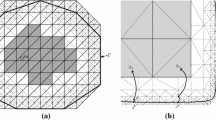Abstract
In this paper, we propose the discrete method of separation of variables for the numerical solutions of the composite material problems on a polygon. After a suitable transformation of coordinates, the original boundary value problem is reduced to a discontinuous coefficients problem on a semi-infinite strip. Then we get the semi-discrete approximation of the discontinuous coefficients problem which is equivalent to a boundary value problem of a system of ordinary differential equations (O.D.E's) with constant coefficients. After solving the boundary value problem of the system by a direct method, then the semi-discrete approximation of the original problem is obtained. Especially we can see that the semi-discrete approximation in form of separable variables naturally possesses the singularity of the original problem. Finally, the numerical examples show that our method is feasible and very effective for solving composite material problems numerically.
Similar content being viewed by others
REFERENCES
Babuska, I. (1974). Solution of Problems with Interface and Singularities, Tech. Note. BN-789, Institute for Fluid Dynamics and Applied Mathematics, University of Maryland.
Babuska, I. (1976). Singularities Problem in the Finite Element Method, Tech. Note. BN-835, Institute for Fluid Dynamics and Applied Mathematics, University of Maryland.
Babuska, I., Kellogg, R.B. and Pitkaranta (1979). Direct and inverse error estimates for finite element with mesh refinements. Numer. Math. 33, 447–471.
Babuska, I. and Oh, H.-S. (1990). The p-version of the finite element method for domains with corners and for infinite domains. Numer. Methods PDEs 6, 371–392.
Babuska, I. and Oh, H.-S. (1992). The p-version of the finite element for the elliptic boundary value problems with interfaces. Comput. Methods Appl. Mech. Engrg. 97, 311–231.
Babuska, I. and Rosenzweig, M.R. (1972) A finite element scheme for domains with corners. Numer. Math. 20, 1–21.
Cherepanov, G.P. (1979). Mechanics of Brittle Fracture, McGraw-Hill, New York.
Cheung, Y.K. and Jiang, C.P. (1996). Application of the finite strip method to plane fracture problems. Engr. Frac. Mech. 53, 89–96.
Comninou, M. (1990). An overview of interface cracks. Engr. Frac. Mech. 37, 197–208.
Costabel, M. and Dauge, M. (1993). Constructions of corner singularities for Agmon-Douglis-Nierenberg elliptic systems. Mathematische Nachrichten 162, 209–237.
land, A.H. (1965). A crack between dissimilar media. J. Appl. Mech. 32, 400–402.
Erdogan, F. (1965). Stress distribution in bonded dissimilar materials with cracks. J. Appl. Mech. 32, 403–410.
Fix, G., Gulati, S. and Wakoff, G.I. (1973). On the use of singular functions with the finite element method. J. Comp. Phys. 13, 209–228.
Han, H. (1982). The numerical solutions of interface problems by infinite element method. Numer. Math. 39, 39–50.
Han, H. (1983). The plane elastic problem with a boundary crack. Acta Scientiarum Naturalium Universitatis Pekinensis 2, 11–25.
Han, H and Huang, Z. (1999). The direct method of lines for the numerical solutions of interface problem. Comput. Meth. Appl. Mech. Engrg. 171, 61–75.
Hendry, J.A. and Delves, L.M. (1979). Global element method applied to a harmonic mixed boundary value problem. J. Comp. Phys. 33, 33–44.
Hutchinson, J.W., Mear, M. and Rice, J.R. (1987). Crack paralleling an interface between dissimilar materials. J. Appl. Mech. 54, 828–832.
Kellogg, R.B. (1971). Singularities in Interface Problems, Numerical Solution of Partial Differential Equations 2(Edited by Huffard, B.), Academic Press, New York.
Kellogg, R.B. (1975). On the Poisson equation with intersecting interfaces. Applicable Anal. 4, 101–129.
Leguillon, D. and Sanchez-Palencia, E. (1987). Computation of Singular Solutions in Elliptic Problems and Elasticity, Masson, Paris.
Li, Z.C. and Mathon, R. (1990). Error and stability analysis of boundary methods for elliptic problems with interfaces. Math. Comp. 54, 41–61.
Lin, K.Y. and Mar, J.W. (1976). Finite element analysis of stress intensity factors at a bimaterial interface. International Journal of Fracture 12, 521–531.
Matos, P.P.L., McMeeking, R.M., Charalambides, P.G. and Drory, M.D. (1989). A method for calculating stress intensities in bimaterial fracture. International Journal of Fracture 40, 235–254.
Papadakis, P.J. and Babuska, I. (1995). A numerical procedure for the determination of certain quantities related to the stress intensity factors in two-dimensional elasticity. Comput. Methods Appl. Mech. Engr. 122, 69–92.
Raveendra, S.t. and Banerjee, P.K. (1991). Computation of stress intensity factors for interfacial cracks. Engr. Frac. Mech. 40, 89–103.
Rice, J.R. (1988). Elastic fracture mechanics concepts for interfacial cracks. J. Appl. Mech. 55, 98–103.
Rice, J.R. and Sih, G.C. (1965). Plane problems of cracks in dissimilar media. J. Appl. Mech. 32, 418–423.
Tan, C.L. and Gao, Y.L. (1990). Treatment of bimaterial interface crack problems using the boundary element method. Engr. Frac. Mech. 36, 919–932.
Williams, M.L. (1959). The stresses around a fault or crack in dissimilar media. Bull. Seismol. Soc. America 49, 199–204.
Xanthis, L.S. and Schwab, C. (1991). The method of arbitrary lines. C.R. Acad. Sci. Paris 312, 181–187.
Yang, Y.Y. and Munz, D. (1997). Stress singularities in a dissimilar materials joint with edge tractions under mechanical and thermal loadings. International Journal of Solids Structures 34, 1199–1216.
Yuuki, R. and Cho, S.B. (1989). Efficient boundary element analysis of stress intensity factors for interface cracks in dissimilar materials. Engr. Frac. Mech. 34, 179–188.
Van der Zande, H.D. and Grootenboer, H.J. (1986). A finite element approach to interface cracks. J. Appl. Mech. 53, 573–578.
Author information
Authors and Affiliations
Rights and permissions
About this article
Cite this article
Han, H., Huang, Z. The discrete method of separation of variables for composite material problems. International Journal of Fracture 112, 379–402 (2001). https://doi.org/10.1023/A:1013548004577
Issue Date:
DOI: https://doi.org/10.1023/A:1013548004577




